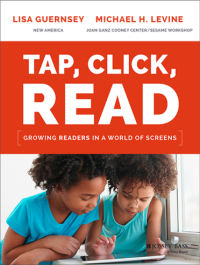“Even preschoolers can grasp what it means to be an author or creator, especially when they themselves are given opportunities to dictate captions under photographs or create their own books using software [or] paper and crayons,” says Guernsey. “The more they learn about authorship, the more keenly they can start to understand information behind why books, games or videos were created.”
Critical literacy involves helping children hone their observational skills. Reading aloud offers rich opportunities to lay this groundwork, says Guernsey. Parents can pause in a story to ask, “What do you think will happen next?” and then “How do you know?” Questions like these challenge children to analyze the pictures and text they encounter -- a technique that can also be used when watching media together.
The Three C’s of a Balanced Media Diet
Guernsey and Levine do not advocate putting babies in front of a screen, but neither do they espouse shielding children from all screentime. They argue that when families can actively engage around media, including digital media, the discussions and conversations that are sparked from those shared experiences can lead to meaningful learning outcomes.
Parents sometimes feel guilty about letting their kids watch TV or use electronic devices, but Guernsey says that this is counterproductive: “Feeling guilty shuts down conversation and leads parents to hide their questions about what movies to watch, what apps to download or what to do about bedtime.” Instead, she says, “we should be helping parents seek high-quality content that is designed for learning.”
To help parents make smarter choices about the media they use with children, Guernsey advocates “The Three C's”: the content, the context and the individual child.
Content: Is this TV show or app designed to support young children’s learning? That’s the key question for parents, but determining the answer isn’t always easy. Levine and Guernsey call the ed-tech marketplace the “Digital Wild West.” To help parents make informed decisions, Levine and Guernsey have put together this list of resources, which includes links to organizations that rate and review apps. But parents need to ask their own critical questions, says Guernsey, such as: “Are there signs that the content is well designed for learning? and “Does it make sense for my child at this age, at this stage in development?”
Context: Strong daily routines help support children’s wellness and intellectual development. A “balanced media diet,” according to Levine and Guernsey, always includes daily exercise, social engagement and good sleep. Finding that balance is crucial for developing the whole child.
Child: When choosing media, parents should tune into each child’s individual disposition. How does a child respond to particular noises, storylines and images? Does media use before bed disrupt sleep? Does watching stories about dinosaurs inspire your child to research these creatures and engage in related imaginative play? In order to answer these questions, parents must be engaged with what their children are viewing and experiencing. Research indicates that “joint media engagement” -- talking with children about what they are viewing, experiencing or creating -- supports cognitive development and helps children learn more from media.
Using Media To Support Literacy
Reading isn’t simply about phonics and fluency. As Guernsey and Levine point out, “one way to predict a good reader is to find a kid who knows a little bit about everything.” Background knowledge helps children make inferences and draw connections -- which are essential for strong reading comprehension.

In order to develop rich background knowledge, a child needs to be exposed to “the thousands of intricate concepts lurking within science, geography, history, government, art, music, movement, mathematics, engineering and, yes, everyday life,” according to Guernsey and Levine. Digital media is a profound resource for this aspect of literacy development -- from viewing short online videos on topics of interest to Skyping with relatives in other parts of the world.
“Consider how much elementary-age children can learn by watching the TV show ‘How It's Made,’ ” says Guernsey. “These little bits of knowledge can be a great help to a child when he or she is reading because they provide some context for ideas and words they may encounter in a nonfiction or fiction book. That will enable them to make inferences and grasp the sentences they read, which helps them to learn more, which helps them to feel confident enough to read more, and so on.”
In fact, say Guernsey and Levine, even parents without strong reading skills can support their children’s cognitive development by using traditional and digital media as a springboard for engagement and conversation.
Guernsey, who has spent a decade studying how media affects child development, says the research has had a profound impact on her own parenting -- particularly the studies around the learning that can take place when families talk about or use media together.
“This doesn't mean that my kids are never alone with media,” says Guernsey. “Of course they are, and there have been plenty of times that I have appreciated the chance to take a phone call or chop tomatoes while they played with an app or watched a video. But I have learned to take advantage of moments to ask my kids why they like a certain character, and to sing their favorite TV show theme song along with them, and, as they grew older, to ask them to critique the apps they were using."



